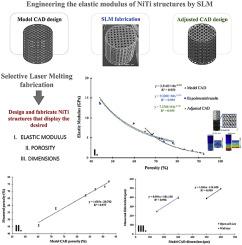Journal of the Mechanical Behavior of Biomedical Materials ( IF 3.3 ) Pub Date : 2020-07-08 , DOI: 10.1016/j.jmbbm.2020.103891 F Bartolomeu 1 , M M Costa 1 , N Alves 2 , G Miranda 1 , F S Silva 1

|
Nickel-titanium (NiTi) cellular structures are a very promising solution to some issues related to orthopaedic implant failure. These structures can be designed and fabricated to simultaneously address a combination of mechanical and physical properties, such as elastic modulus, porosity, wear and corrosion resistance, biocompatibility and appropriate biological environment. This ability can enhance the modest interaction currently existing between metallic dense implants and surrounding bone tissue, allowing long-term successful orthopaedic implants. For that purpose, NiTi cellular structures with different levels of porosity intended to reduce the elastic modulus were designed, modelled, selective laser melting (SLM) fabricated and characterized. Significant differences were found between the CAD design and the SLM-produced NiTi structures by performing systematic image analysis. This work proposes designing guidelines to anticipate and correct the systematic differences between CAD and produced structures. Compressive tests were carried out to estimate the elastic modulus of the produced structures and finite element analyses were performed, for comparison purposes. Linear correlations were found for the dimensions, porosity, and elastic modulus when comparing the CAD design with the SLM structures. The produced NiTi structures exhibit elastic moduli that match that of bone tissue, which is a good indication of the potential of these structures in orthopaedic implants.
中文翻译:

设计通过选择性激光熔化制备的NiTi蜂窝结构的弹性模量。
镍钛(NiTi)细胞结构是非常有前途的解决方案,可以解决与整形外科植入物失败相关的某些问题。可以设计和制造这些结构,以同时解决机械和物理特性的组合,例如弹性模量,孔隙率,耐磨性和耐腐蚀性,生物相容性和适当的生物环境。这种能力可以增强金属致密植入物与周围骨组织之间目前存在的适度相互作用,从而可以长期成功地用于整形外科植入物。为此,设计,建模,建模和表征了选择性降低激光熔化(SLM)的具有不同孔隙率的NiTi蜂窝结构,以降低弹性模量。通过进行系统的图像分析,发现CAD设计与SLM生产的NiTi结构之间存在显着差异。这项工作提出了设计指南,以预期和纠正CAD与生产结构之间的系统差异。为了进行比较,进行了压缩试验以估计所生产结构的弹性模量,并进行了有限元分析。将CAD设计与SLM结构进行比较时,发现尺寸,孔隙率和弹性模量具有线性相关性。产生的NiTi结构具有与骨组织相匹配的弹性模量,这很好地表明了这些结构在整形外科植入物中的潜力。这项工作提出了设计指南,以预期和纠正CAD与生产结构之间的系统差异。为了进行比较,进行了压缩试验以估计所生产结构的弹性模量,并进行了有限元分析。将CAD设计与SLM结构进行比较时,发现尺寸,孔隙率和弹性模量具有线性相关性。产生的NiTi结构具有与骨组织相匹配的弹性模量,这很好地表明了这些结构在整形外科植入物中的潜力。这项工作提出了设计指南,以预期和纠正CAD与生产结构之间的系统差异。为了进行比较,进行了压缩试验以估计所生产结构的弹性模量,并进行了有限元分析。将CAD设计与SLM结构进行比较时,发现尺寸,孔隙率和弹性模量具有线性相关性。产生的NiTi结构具有与骨组织相匹配的弹性模量,这很好地表明了这些结构在整形外科植入物中的潜力。比较CAD设计与SLM结构时的孔隙率和弹性模量。产生的NiTi结构具有与骨组织相匹配的弹性模量,这很好地表明了这些结构在整形外科植入物中的潜力。比较CAD设计与SLM结构时的孔隙率和弹性模量。产生的NiTi结构具有与骨组织相匹配的弹性模量,这很好地表明了这些结构在整形外科植入物中的潜力。











































 京公网安备 11010802027423号
京公网安备 11010802027423号